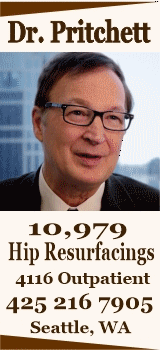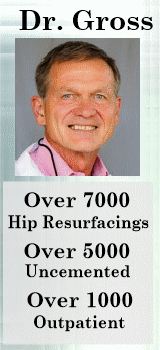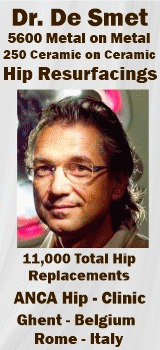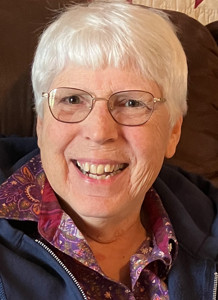Watching Dr. Kusuma perform a live BHR surgery
I had the opportunity to watch a live BHR hip resurfacing surgery at Grant Medical Center in Columbus, OH on Oct. 7, 2011. The story below is from a layman’s perspective since I am not medically trained. I have written the story so patients can understand the basic procedures during surgery. I explain things so perspective patients can understand them. I am not trying to write a technical article on hip resurfacing surgery. It is my observations about what was happening in the OR.
Watching a live surgery as an observer is quite different than being a patient. As a patient, I never saw the inside of an operating room. The special shot given to relax me always put me to sleep before entering the OR. Being awake and watching the staff the OR for a BHR surgery is very interesting. The room is a beehive of activity. No one is rushing but everyone is doing their job efficiently while a little small talk occurs.
While the staff is preparing for the surgery, the Smith and Nephew representative selects the proper sized BHR device. He also selects one size larger and one size smaller than the determined size to be used during the surgery. A special room stores all of the Medical Devices at the hospital. The representative from each medical company keeps the shelves stocked for their own devices.
Once the patient is prepared, Dr. Kusuma, is ready to begin. His staff is a very competent and obviously use to working with him. His PA assists him in all of his surgeries. The staff was aware I was observing the surgery and was very helpful in placing the video cameras so I could see everything that was happening.
Before surgery, Dr. Kusuma had studied the x-rays and used his templating system to determine where the middle of the neck of the femur bone was. He studied both the x-rays and his drawings for the correct placement of the femur cap on the center of the femur neck.
The BHR device was packaged in several sterile packages. The first box was opened by the representative and handed to an assistant. They opened the second package and handed it to the surgery assistant. All checked carefully, that the size was correct. There were many eyes checking many things all through the surgery. Everyone paid close attention even when they were not directly involved in the step being performed.
Dr. Kusuma prepared to make the first incision to expose the hip joint. He explained about the various muscles and ligaments he was working with as he surgically cut into the hip joint. I watched many surgeries on the Internet and at hip resurfacing courses, but watching a live surgery was quite different. I was able to see every step take place. Usually the videos only included the major part of the BHR component placements. Dr. Kusuma uses the posterior approach with a large incision for best exposure.
He was very careful to preserve as much tissue around the neck of the femur to help maintain a good blood supply. When he uses the instrument to rotate around the femur neck to determine its center and size, he uses a tighter fitting setting than most surgeons use. This way he knows he is well centered.
Dr. Kusuma does the preliminary shaping of the femur ball leaving enough bone to allow him to change the diameter of the femur cap if needed after setting the acetabular cup. As I watched him work and listened to his comments to me, I realized once again, that hip resurfacing surgery is as much an "art" as it is a skill. There is more involved than just the information previously learned by the brain. There is an inner knowledge or awareness of what seems right. It is like any great athlete who just knows what to do without thinking about it. It is that experience and skill acquired throughout the years that also guides him along with his conscious decisions. The experience of doing hip resurfacing surgeries over and over helps him make the decisions without having to think about every one of them as he moves from one step to another.
The PA helps to rotate the leg and dislocate the joint to expose the acetabular portion of the hip. Any of the bone spurs or bony growths are removed from the joint very carefully. They must be cleaned away so there is no interference or impingement after the acetabular cup is set. The cup depression is removed with a type of router, almost like those used in woodworking. After the surgeon is happy with the preparation, the acetabular test cup is put into place. After testing and checking everything, the final acetabular cup is help by a special tool and then pounded into place. Dr. Kusuma prefers to hold the tool attached to the cup while his assistant taps the component into place. He feels this provides a better placement than when he tries to hold and tap at the same time.
Once the acetabular cup is in place, he goes back to finishing and shaping the ball of the femur. He placed special draping cloths around the femur bone and neck to protect it from all the small bone chips and fragments that are removed with the shaping or routing tool. The drills and routers all look very much like woodworking tools and are battery operated. I am sure they cost much more than normal woodworking tools! The femur ball is shaped to accept the cup that will match with the acetabular cup already placed in the hip.
The femur cap is placed on the femur with cement and tapped for a forced fit. The cement operation is very interesting. It has two components something like epoxy. The cement must be timed because it has a reaction and then sets – right now. I was able to feel a small amount in my hand. As it gets ready to "fire" or set, it becomes warm and quickly becomes very hard. This is a tricky part of the surgery because everything must be timed correctly. Also the right amount of cement must be added to the inside of the femur cap. The amount of cement is critical because too little will not allow good adhesion and too much can prevent good bone growth. The pin of the femur cap is not cemented and is only used to place the cap. The representative is calling out the time so the surgeon and assistants know when the cement is ready to set. The femur cap is also tapped onto the properly shaped femur bone. A few extra holes are drilled into the femur bone to allow the cement to penetrate.
The leg is flexed and rotated to make sure that the components are placed properly and there is no problem. There should not be any impingement and everything should move smoothly. This test is performed several times with the test components and after the actual components are installed.
After the femur cap has been cemented and tapped into place, it is time to clean up the area. The sterile drape is removed with all the pieces from the shaping and the extra cement is also removed that has squirted out from the cap. There is not much as I can tell, but the surgeon is very careful to clean it all up. After everything is in place, the whole area is washed with sterile fluids. After that, everything is washed several times with betadine.
Dr. Kusuma does the initial stitching when closing the incision. He does the first several layers, then his PA closes the rest of the incision. The outer layer is stapled closed.
An x-ray is taken right after surgery to show the placement of the omponents. The x-ray showed the femur cap pin to be in the middle of the femur neck and the acetabular component placed at an optimum angle.
I realized several things as I observed the live surgery. Most importantly, the surgeon that is very experienced is as much an "artist" and a surgeon. There are instinctive moves and decisions made by the experienced surgeon that he does not even have to think about. The surgeon's actions are like a pro athlete, musician or artist meaning they are doing something they love and make many intuitive decisions based on a great deal of experience and talent.
I think the most important aspect of the live surgery which impressed me is how much both the surgeon and all of the staff in the OR cared about the patient. They are all very attentive and treat the patient with respect and kindness. I watched one person give the patient a gentle pat on the leg as if to say "everything will be OK because we are here and care about you." Everyone appeared to care and want to be there, they were not counting the minutes or hours until quitting time. I know they do this day in and day out, but there was a feeling of caring and wanting to do a great job.
I appreciate the opportunity Dr. Kusuma and Grant Medical Center offered me to observe a live surgery. I learned more about hip resurfacing and learned about the great staff at Grant.











